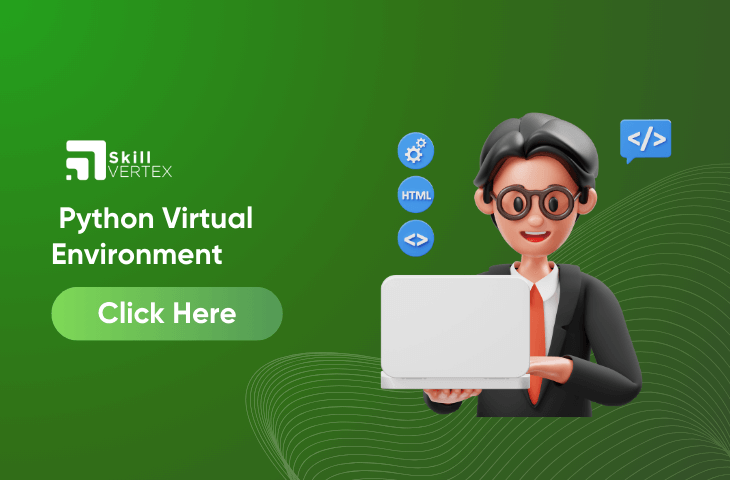Table of Contents
Python virtual environment will make a virtual installation of Python inside the Python directory. Then, users will install and monitor Python Packages from several other projects. This article will tell you about the virtual environment in Python.
Moreover, it will help the users install packages and change the Python environment without breaking off the packages that are installed in the other environment.
What is Python Virtual Environment?
Python virtual environments are :
- Disposable Nature: Virtual environments are like temporary workspaces for your Python projects. Once you’re done with a project, you can remove this workspace without affecting others.
- Purpose: Each virtual environment is a self-contained package that holds a specific Python version and the exact tools your project needs. This avoids conflicts between different projects using different tools.
- Directory Convention: Virtual environments are typically stored in a folder named “venv” or “.venv” within your project directory. This keeps things organized and helps Python recognize these special environments.
- Immovable/Copyable: While virtual environments are portable, it’s not recommended to directly copy them or move them between projects. It’s better to recreate the environment based on the project’s requirements.
Creating a virtual environment is like setting up a controlled environment for your project, ensuring that the project has all the necessary tools without interfering with other projects. It’s a way of maintaining order in the Python ecosystem.
How to Use a Virtual Environment for Python Application?
After installing Python software on your computer and will be accessible from anywhere in the system. It is a system-wide installation.
During the creation of the application in Python, more libraries are needed to be installed with the pip utility. Further, the application must need a particular version of the library. Similarly, another Python application ( example: App2) needs a newer version of the same library so, let’s suppose some lib 2.0. Therefore, installing this new version can allow the functionality to be compromised due to the conflict between two different versions of the same library.
Further, this conflict will be neglected by allowing the two isolated environments of Python on the same machine. It is referred as a virtual machine. A virtual environment is considered a separate directory structure and has an isolated installation with a local copy of Python Interpreter, a standard library, and several other modules.
With the global Python installation, it is possible to make more than one virtual environment. Each virtual environment has a different version of the same library. Thus, this can help to avoid the conflict.
This functionality will be supported by the venv module in the standard Python distribution. To create a new virtual environment, use the command given below:
C:\Users\Acer>md\pythonapp
C:\Users\Acer>cd\pythonapp
C:\pythonapp>python -m venv myvenvmyvenv is considered as the folder that has a new Python Virtual environment and can make the directory structure given below
Directory of C:\pythonapp\myvenv
22-02-2023 09:53 <DIR> .
22-02-2023 09:53 <DIR> ..
22-02-2023 09:53 <DIR> Include
22-02-2023 09:53 <DIR> Lib
22-02-2023 09:53 77 pyvenv.cfg
22-02-2023 09:53 <DIR> ScriptsTherefore, the utilities that are used for activating and deactivating the virtual environment and the local copy of the Python interpreter will be stored in the scripts folder.
Directory of C:\pythonapp\myvenv\scripts
22-02-2023 09:53 <DIR> .
22-02-2023 09:53 <DIR> ..
22-02-2023 09:53 2,063 activate
22-02-2023 09:53 992 activate.bat
22-02-2023 09:53 19,611 Activate.ps1
22-02-2023 09:53 393 deactivate.bat
22-02-2023 09:53 106,349 pip.exe
22-02-2023 09:53 106,349 pip3.10.exe
22-02-2023 09:53 106,349 pip3.exe
22-02-2023 09:53 242,408 python.exe
22-02-2023 09:53 232,688 pythonw.exeExecute the activate.bat in the Scripts folder to allow the new virtual environment.
C:\pythonapp>myvenv\scripts\activate
(myvenv) C:\pythonapp>Remember to note the name of the virtual environment in the parenthesis. Whereas, the script folder has a local copy of Python Interpreter. Then, start a Python Session in the virtual environment. Check the sys. path to confirm if the Python session is in the virtual environment.
(myvenv) C:\pythonapp>python
Python 3.10.1 (tags/v3.10.1:2cd268a, Dec 6 2021, 19:10:37) [MSC v.1929
64 bit (AMD64)] on win32
Type "help", "copyright", "credits" or "license" for more information.
>>> import sys
>>> sys.path
['', 'C:\\Python310\\python310.zip', 'C:\\Python310\\DLLs',
'C:\\Python310\\lib', 'C:\\Python310', 'C:\\pythonapp\\myvenv',
'C:\\pythonapp\\myvenv\\lib\\site-packages']
>>>Hence, the script folder of the virtual environment has pip utilities. Therefore, after installing a package from PyPI, the package will be seen as active only in the virtual environment. Run deactivate.bat to deactivate the environment.
Conclusion
To conclude, a Python virtual environment is like a special workspace or toolbox for each of your projects. It helps keep everything tidy and separate, so tools from one project don’t mix up with tools from another. It’s like having individual backpacks for different school subjects.
Furthermore, it creates a new one whenever you start a project, and when you’re done, you can easily toss it away. This way, your projects stay organized, and you always have the right tools for the job without any confusion.
Python-Virtual Environment- FAQs
Q1. Which virtual environment is best for Python?
Ans. Python venv is the virtual environment that is best for Python.
Q2.What are the two advantages of Python virtual environments?
Ans. Python virtual environments will allow developers to monitor software dependencies in Python code.
Q3. Should I use Anaconda or venv?
Ans. Venv might be the best choice as it is very simple and easy to use.
Hello, I’m Hridhya Manoj. I’m passionate about technology and its ever-evolving landscape. With a deep love for writing and a curious mind, I enjoy translating complex concepts into understandable, engaging content. Let’s explore the world of tech together

